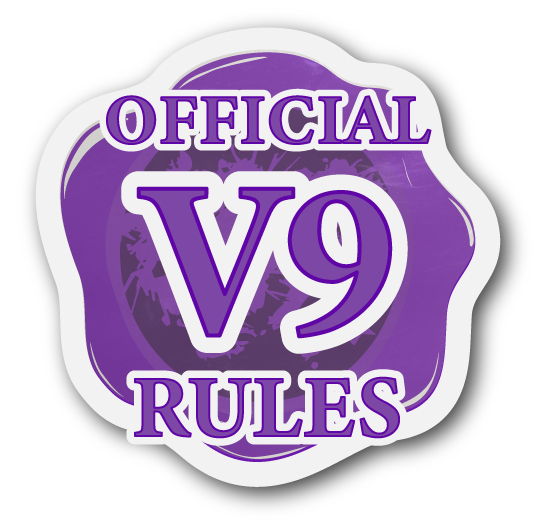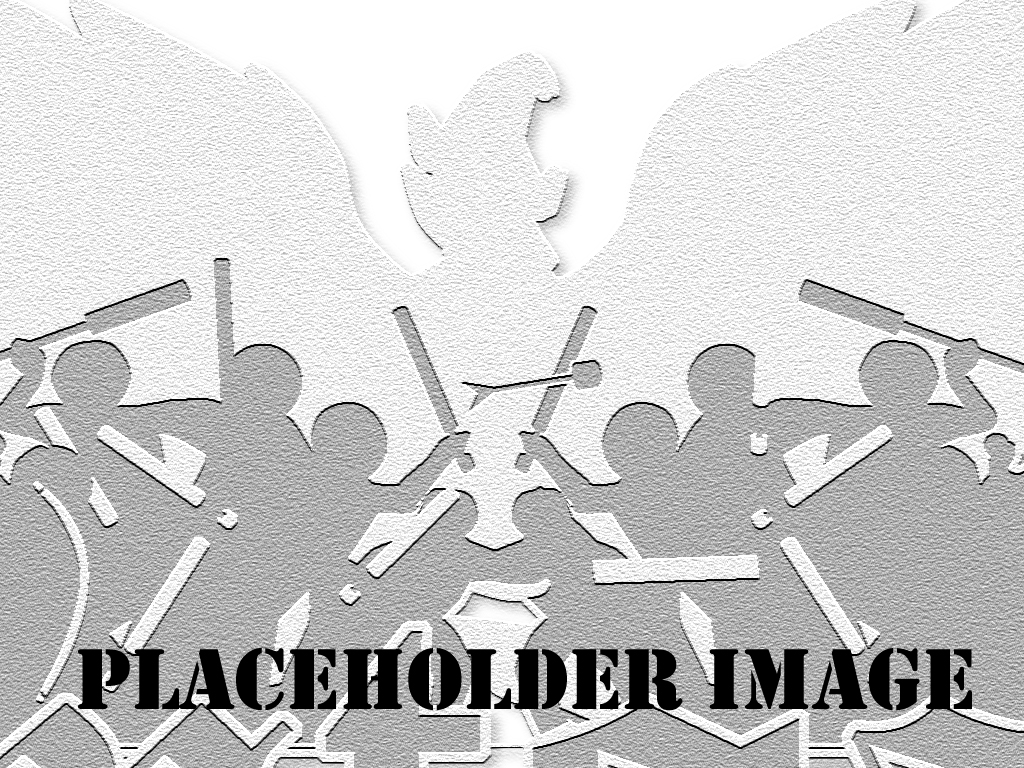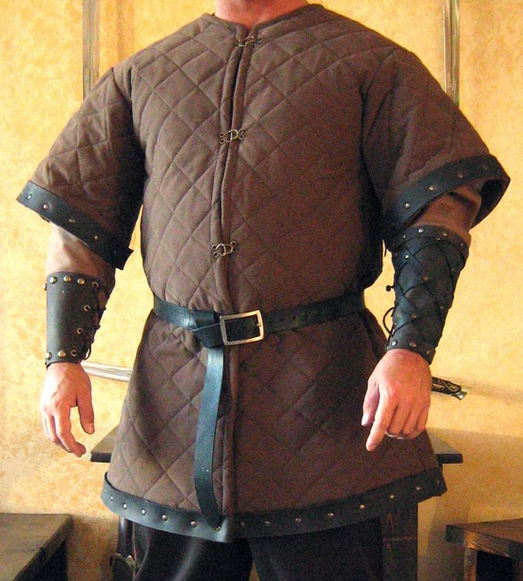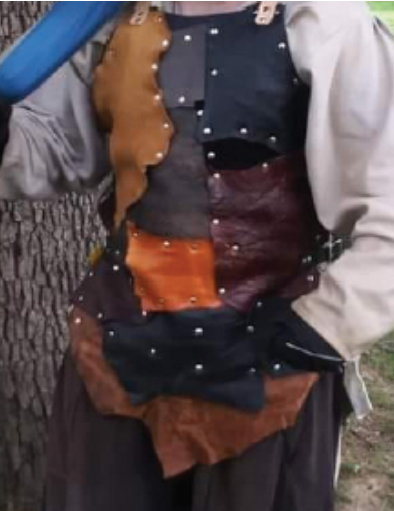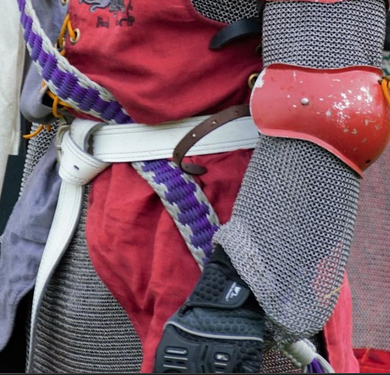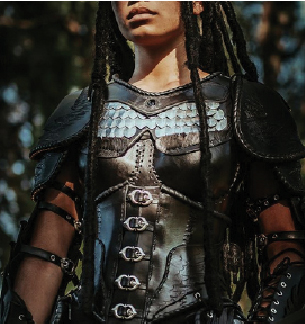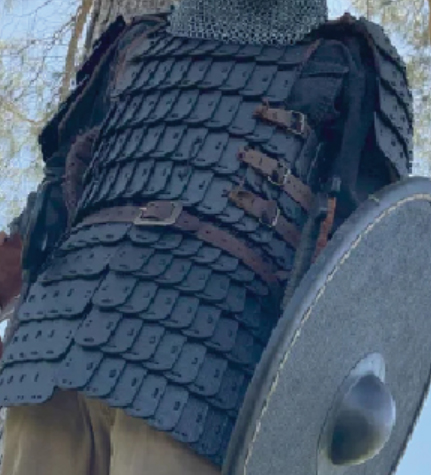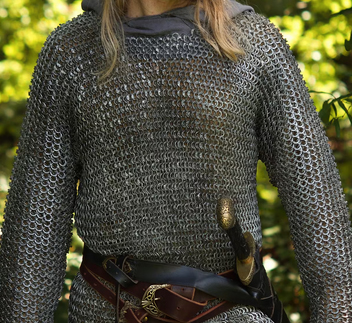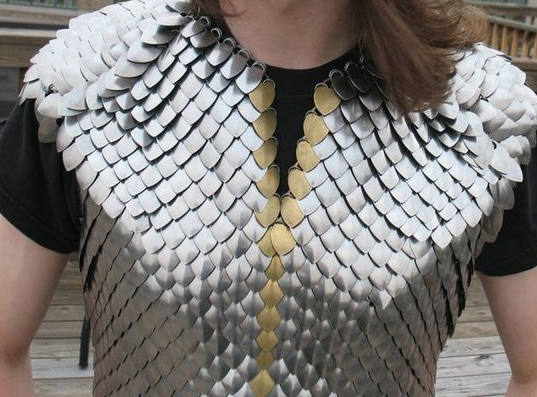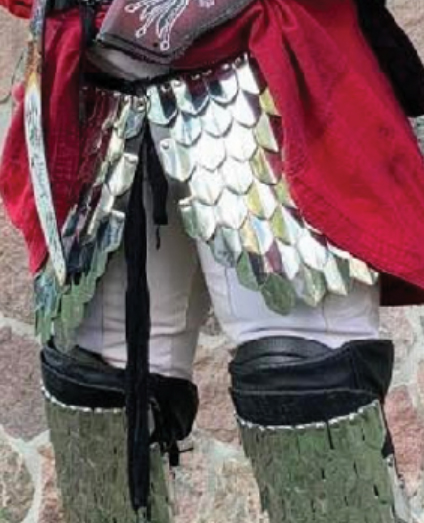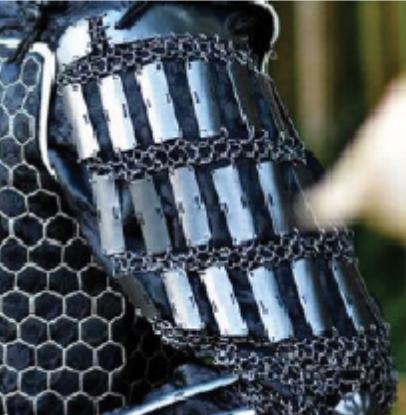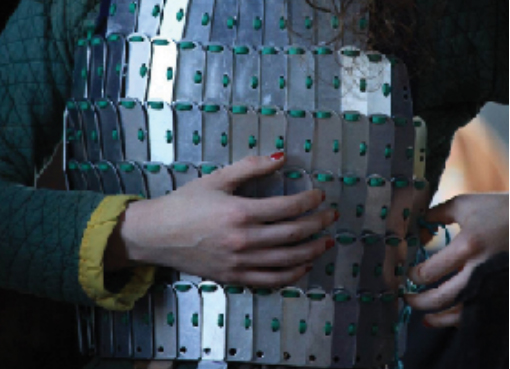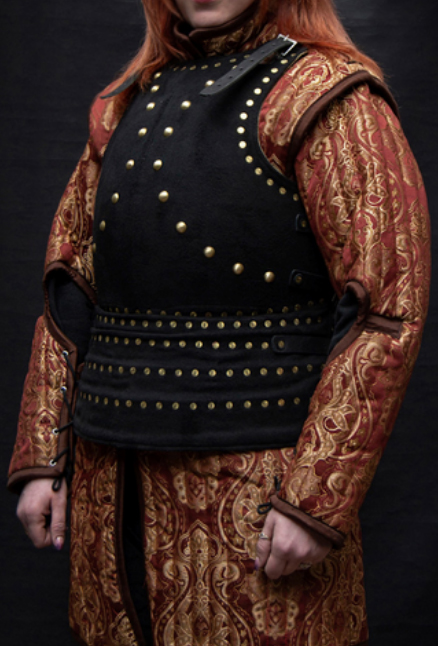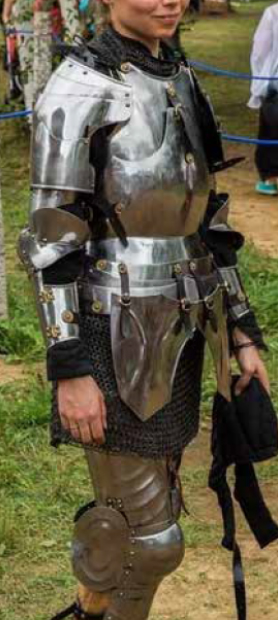V9: Armor
- The Amtwiki is the official home and primary source for Amtgard V9 Rules as of February 25, 2023.
- These rules are currently in Open Alpha Playtest. See the Playtest Disclaimer for more details.
- To learn more about Amtgard V9 Development, please visit Amtgard.com.
- To view the current Amtgard V8 ruleset, please see the Amtgard V8 Rulebook.
Contents
- 1 Armor
- 1.1 General Rules
- 1.2 Natural Armor
- 1.3 Physical Armor
- 1.3.1 Gameplay Rules
- 1.3.2 Construction Rules
- 1.3.3 Rating Armor & Calculating Armor Point Totals
- 1.3.4 Armor Styles
- 1.3.4.1 Cloth/Padded Armor
- 1.3.4.2 Light Leather
- 1.3.4.3 Butcher's Mail, Sharkmail, etc
- 1.3.4.4 Heavy Leather
- 1.3.4.5 Rigid Non-Metal Armor
- 1.3.4.6 Chainmail
- 1.3.4.7 Light Scale
- 1.3.4.8 Heavy Scale
- 1.3.4.9 Butted Plate (Splint, Kikko, etc.)
- 1.3.4.10 Lamellar and Laminar
- 1.3.4.11 Brigandine
- 1.3.4.12 Plate
- 1.3.4.13 Ambiguous Armor
Armor
General Rules
Armor grants an advantage in combat by protecting the wearer from physical strikes.
- Armor grants protection in the form of Armor Points.
- When armor in a Hit Location is struck, the victim loses one Armor Point in that location instead of suffering a Wound. If the location struck has no points to lose, the victim will suffer a wound as normal.
- Armor pieces do not track their damage individually. Instead, each Hit Location has an armor point total that is determined by averaging of all armor covering that area.
- Armor only protects what it physically covers. If your elbow is exposed and you are struck in that gap, you will suffer a wound but do not lose any Armor Points.
- Straps and other such material that hold the armor pieces on do not count as part of the armor unless they are specifically built to be as such. (A leather strap across your back holding on your breastplate will not protect you from strikes.)
- Armor Priority: If a strike hits the line between an armored area and an exposed area, the strike will count as only hitting the armor. In other words, if a player wants to strike a gap in your armor, their attack must cleanly hit inside the gap without touching any armor. Armor Priority is superseded by Torso Priority when applicable.
- Armor present on a wounded Hit Location will continue to function and protect against further blows as long as it has armor points to do so.
- There are two types of armor in Amtgard: Natural Armor and Physical Armor.
- A player can only benefit from a single armor type at a time.
- Rules that reference "Armor" in general apply to both types.
- Rules that reference a specific armor type will only affect that type.
Natural Armor
Natural Armor grants an armor rating to the bearer’s skin. A player with natural armor will always have full armor coverage no matter where they are struck. For example: A player with 2 points of Natural Armor will have 2 armor points protecting every inch of every hit location, even while wearing no physical armor pieces.
V8 Transition Note: Natural armor functions exactly like physical armor except that it does not require any actual armor pieces. It cannot have points restored with Heal and it does not have any other special rules that may have been present in previous editions of Amtgard.
Physical Armor
Gameplay Rules
- Physical Armor is represented on a player by actual pieces armor worn by the player.
- Each physical piece is inspected and given an individual Armor Rating which is used to calculate the armor point total for each Hit Location.
- The maximum amount of armor points a Hit Location can ever receive from Physical Armor is six (6). Some Classes will limit this amount further.
- Limits are only applied after armor point totals are fully calculated. Armor Ratings higher than 6 may be used to benefit averaging calculations before the limit is applied.
Example: Ariq is playing a class which has a maximum armor point total of 4pts. He is wearing armor pieces that average to 6 points on his torso, 2 points on his arms, and 1 point on his legs. Since his class has an armor limit of 4 points, Ariq's torso armor is reduced to 4 points for the duration of that game and his arm and leg values remain unchanged. - When worn, armor pieces must be at least partially visible in a way that does not misrepresent the wearer’s potential armor point totals and/or coverage.
- If it is necessary to add or remove pieces of physical armor after a game has started, new armor point totals should be recalculated and adjusted as soon as reasonably possible.
- If armor point values must be adjusted while the player is still alive (possibly with damaged armor), the damage to that location will persist through the equipment change. If the location had suffered 2 damage, the new total will also suffer 2 damage. If the location had zero points remaining, it will always stay at zero even if the new armor pieces increases the maximum point value. If the entire hit location is replaced with new armor that has not been worn during that life, then the current armor value may be restored to maximum value.
Example 1: Delilah is wearing a bracer and gambeson that grants her a total of 4 points on her arm. She suffers 1 damage which reduces her remaining armor points to 3. For whatever reason, she discovers she needs to get rid of the bracer. Her new armor averages to only 2 points so she sets her new maximum to 2 and then applies the 1 damage she has already received, leaving her with 1 point remaining on her arm. Example 2: Robin is wearing a 2pt leather chestpiece on their torso. They suffer damage and are reduced to 0pts remaining. They are then given a 5pt breastplate mid-combat. They remove the leather and put on the breastplate. Since they completely replaced the armor on their torso with new pieces, the don't have to carry over the damage and they can benefit from the full 5pts immediately. If they had some other piece on their torso that didn't get changed out, their maximum would still increase to 5pts but their current value would remain at zero.
Construction Rules
- Must adhere to the Universal Equipment Requirements.
- Must not be easily mistaken as regular garb, nor be obviously synthetic in appearance, even if obscured or otherwise covered.
- Easily damaged materials (such as paper, cardboard, and tinfoil) and obviously modern materials (such as shin pads and chest pads) may never be considered armor on their own. Such materials and items may be used as components of armor but the final product must still meet all other requirements and construction standards in order to receive an Armor Point Rating.
- Armor that does not deform locally when struck must ensure all exposed corners are at least penny round (3/8" radius).
- Loose scales and similar components that move individually as part of piece that deforms locally do not need to be penny round.
- Rigid scales and similar components that are firmly affixed onto a shell must only be rounded if they protrude from the armor.
To Build or to Buy?
Armor construction is a lot more complex than weapon construction. This rulebook simply cannot provide all the information required to teach a novice how to build their own armor. We recommend taking the time to learn from experienced players or studying online tutorials and guides.
Alternatively, you can simply purchase pre-made armor from other players or online vendors. If you wish to take this route, make sure to do your research and ensure it will meet all the requirements necessary for Amtgard armor. Once again, we recommend taking the time to speak with experienced players or studying online discussions.
Rating Armor & Calculating Armor Point Totals
Rating Armor Pieces
Each piece of Physical Armor must be inspected and given an Armor Rating in order to be used for Amtgard combat.
- Physical Armor pieces must be examined and rated by an Equipment Inspector.
- Each piece of physical armor will be assigned to an Armor Tier based on its style that will outline its Base Armor Rating and Maximum Armor Rating. Armor that cannot be assigned to a tier does not count as armor and cannot be used as such.
- Pieces can be granted bonuses or penalties based on the quality of construction or appearance.
- The sum total of all modifiers cannot increase a piece's armor rating beyond the maxiumum allowable for its tier. Surplus bonuses confer no additional benefit.
- Armor with a final rating of zero or less (due to penalties) does not count as Armor and cannot be used as such.
- Armor Pieces are rated individually but will be averaged together when worn to produce an Armor Point Total for each Hit Location.
Armor rating can be subjective at times. To help mitigate this, it is recommended that players keep a reference sheet with a list of details for their physical armor pieces including descriptions, construction details, and previously assigned ratings to help Inspectors make quick and confident assessments. Keeping signatures and inspection dates from other Inspectors will add further credibility to your notes.
Reference Sheets are not necessary but they will greatly improve your odds of getting consistent armor ratings at every event you attend!
Armor Tiers
Armor tiers provide a base and maximum rating for physical armor pieces. Each tier includes a list of common styles that fall under that tier. Ambiguous armor pieces should be placed wherever they would be most appropriate.
| ARMOR TIERS | |||
|---|---|---|---|
| TIER | BASE RATING |
MAX RATING |
INCLUDES |
| T1 | 1 | 2 | |
| T2 | 2 | 3 | |
| T3 | 3 | 4 | |
| T4 | 4 | 5 | |
| T5 | 5 | 6 | |
| T6 | 6 | 7 | |
| Special | - | - | |
Armor Modifiers
Armor pieces can be granted bonuses or penalties to their Armor Rating based on the quality of construction or appearance. Multiple points can be awarded and penalized simultaneously as long as they each correspond to each unique feature or collection of features that would warrant the bonus or penalty if viewed on its own.
Superior Appearance
Bonus points may be awarded to armor that displays an exceptional appearance above and beyond the typical appearance of similar pieces in its style. This includes but is not limited to: tooling, etching, gilding, and fluting, as well as notable use of colors, shapes, weaves, etc. These examples do not represent an exhaustive list and consideration should be given to any piece that obviously goes above and beyond the base construction requirements to create an aesthetically pleasing piece.
Inferior Appearance
Points may be deducted from armor that displays an appearance well below the typical standard expected for similar pieces in that style. Examples include tarnished/poorly-maintained armor as well as visibly inauthentic or degraded materials. This penalty does not apply when the piece is worn as a part of a complete outfit that is intentionally designed to look shoddy or battle-worn.
Superior Construction
Bonus points may be awarded to armor constructed with exceptional techniques that provide a meaningful increase in durability over the standard for the material being used. This includes but is not limited to: solid/riveted rings, hardened material, noticeably tighter spacing than required, etc. These examples do not represent an exhaustive list and consideration should be given to any piece that obviously goes above and beyond the base requirements to create a more durable piece. This bonus may also be granted to pieces that are at least 75% constructed from metal materials that are significantly more dense and/or durable than aluminum.
Inferior Construction
Points may be deducted from armor for inferior construction techniques or a meaningful reduction in expected durability when compared to the standard for the material being used. Examples include but are not limited to: obviously unfinished armor, brittle/cracked material, loose connection points, and shoddy workmanship.
Layered Armor Bonus
If multiple unique pieces of Physical Armor are layered on top of each other as part of a complete outfit, the rating of any overlapping area will be rating of the highest-tier armor piece plus 1, up to that armor’s maximum.
- A piece of armor already at max rating will not receive any additional value from layering.
- Each layered piece should be able to act as armor on its own if it were not layered. The layers may be affixed while being worn, such as metal armor attached to an arming doublet.
- Any part of layered armor that extends beyond the layering is calculated at its normal rating.
- All layered armor pieces must be at least partially visible in a way that does not misrepresent the wearer’s armor point total or armor coverage when observed by another player from 20ft away. This especially true in the cases where a lower-tier armor is layered on top of a higher-tier piece.
- There is no additional bonus for layering more than two pieces.
Material Thickness
Certain armor styles may require materials that meet a specific thickness. Multiple layers of material may permanently affixed to each other to increase thickness however extra thickness caused by adhesives or empty space should not be factored into the new measurements.
- One bonus point may be awarded or deducted for Superior or Inferior thickness according to the chart below.
- Armor pieces that do not meet these minimum requirements may be judged as Ambiguous Armor as long as they still meet the universal equipment requirements.
| MATERIAL THICKNESS REFERENCE CHART | |||||||
|---|---|---|---|---|---|---|---|
| Inferior (Minimum) |
Standard | Superior | Notes | ||||
| Cloth | Cannot be less than standard |
1/16" 1.60mm |
1/8" 3.18mm | ||||
| Light Leather | 4oz 1/16" 1.60mm |
6oz 3/32" 2.39mm |
8oz 1/8" 3.18mm | ||||
| Heavy Leather | Cannot be less than standard |
10oz 5/32" 3.96mm |
12oz 3/16" 4.78mm |
Less than standard is Light Leather | |||
| Rigid, Non-Metal | 1/8" 3.18mm |
3/16" 4.78mm |
1/4" 6.36mm |
Material Density at least 0.9g/cm3 (equivalent to HDPE) | |||
| Aluminum | Steel | Aluminum | Steel | Aluminum | Steel | ||
| Round Rings | 18ga swg 16ga awg 0.048" 1.219mm |
20ga swg 18ga awg 0.036" 0.914mm |
16ga swg 14ga awg 0.064" 1.626mm |
18ga swg 16ga awg 0.048" 1.219mm |
14ga swg 12ga awg 0.080" 2.032mm |
16ga swg 14ga awg 0.064" 1.626mm | |
| Flat Rings | 20ga swg 18ga awg 0.036" 0.914mm |
22ga swg 20ga awg 0.028" 0.711mm |
18ga swg 16ga awg 0.048" 1.219mm |
20ga swg 18ga awg 0.036" 0.914mm |
16ga swg 14ga awg 0.064" 1.626mm |
18ga swg 16ga awg 0.048" 1.219mm |
Measure along thinnest axis. Punched rings should be comparable thickness. |
| Sheet Metal | 18ga 0.040" 1.024mm |
20ga 0.036" 0.911mm |
16ga 0.051" 1.291mm |
18ga 0.048" 1.214mm |
14ga 0.064" 1.628mm |
16ga 0.060 1.518mm | |
| Scales | 20ga 0.032" 0.812mm |
22ga 0.030" 0.759mm |
18ga 0.040" 1.024mm |
20ga 0.036" 0.911mm |
16ga 0.051" 1.291mm |
18ga 0.048" 1.214mm | |
Supplemental Armor Bonus
When calculating a player's Armor Point Total, armor worn on the head (above the neck), hands (above the wrist), or feet (below the ankle) do not contribute a normal rating towards calculations. Instead, pieces that meet the construction criteria below grant an additional +1 bonus to their respective location (torso, right arm, left arm, right leg, left leg) after all Armor Point Totals have been calculated.
- Supplemental armor pieces must cover at least 50% of the surface area of the head, hand, or foot, not including space between fingers and toes.
- They meet the Universal Equipment Requirements, as well as be constructed in a way that would place them in Tier 3 or greater.
- To ensure safety in the cases of accidental hand contact, hand armor cannot include metal or similarly rigid materials on the tops of knuckles or fingers, including fingertips. To offset this, Hand Armor can also be constructed as a Tier 2 armor so long as the final piece still looks like armor.
- This bonus can cause the armor point total to exceed tier maximums, however it will still be affected by armor point limits imposed by class or game modes.
- If hand or foot armor is the only armor piece worn on that location, then it should be compared to the normal armor tiers and assigned a normal rating as best as possible.
Calculating Armor Point Totals
Once the pieces are rated, Armor Point Totals are calculated for each Hit Location based on those ratings and the approximate physical coverage that each piece bestows.
To calculate this total, average the ratings of all physical armor pieces in the hit location based on the percentage of coverage they provide, rounding the result to the nearest whole number.
- Areas not covered by any armor whatsoever, such as gaps or garb, are not factored into this averaging.
- You do not need to be precise when determining the coverage. "Eyeballing" it is perfectly fine and is even encouraged as long as it is done in good faith.
Once the point total has been calculated, any extra points from Supplemental Armor should be added.
Lorathana is wearing a cloth bracer (rated 2pts) on her right forearm, a chainmail tunic (rated 4pts) with sleeves covering some of her arms, and a leather gauntlet. The two pieces together cover about 70% of her arms, leaving a gap at the elbow.
To make their calculations, the Equipment Inspector only has to focus on the area covered by armor. Looking at her arm, they determine that the bracer takes up about 40% of the armored area and the chainmail sleeve takes up about 60% of the armored area. The Gauntlets are Supplemental Armor so they are ignored until later.
[Bracer] 2pts x 40% = 2 x 0.40 = 0.8
[Sleeve] 4pts x 60% = 4 x 0.60 = 2.4
0.8 + 2.4 = 3.2 rounds down to 3.
Now that the total has been calculated, Lorathana can add the Supplemental Armor bonus for her Gauntlets, granting an additional +1.
Therefore, Lorathana’s right arm has an Armor Point Total of 4pts in the areas covered by armor (the bracer, the sleeve, and the gauntlets) and an exposed gap between them.
Still confused? More examples can be found here.
Armor Styles
Each Armor Tier includes a list of common Armor Styles that fall under that tier. Those styles are presented here in greater detail to help players and inspectors more accurately assess their armor. Ambiguous armor pieces should be assessed on a case-by-case basis.
| ARMOR TIERS | |||
|---|---|---|---|
| TIER | BASE RATING |
MAX RATING |
INCLUDES |
| T1 | 1 | 2 | |
| T2 | 2 | 3 | |
| T3 | 3 | 4 | |
| T4 | 4 | 5 | |
| T5 | 5 | 6 | |
| T6 | 6 | 7 | |
| Special | - | - | |
Cloth/Padded Armor
This style includes armor made of fabric, padding, and/or synthetic equivalents.
- Is a Tier 1 armor style.
- Must meet the Universal Equipment Requirements.
- Minimum Material Thickness of 1/16" (1.60mm)
Light Leather
This style includes armor made of thin leather, hides, furs and their synthetic equivalents.
- Is a Tier 2 armor style.
- Must meet the Universal Equipment Requirements.
- The standard Material Thickness is 6oz (3/32") (2.39mm).
Butcher's Mail, Sharkmail, etc
This style includes armor composed of machine-made weaves of very small rings.
- Is a Tier 2 armor style.
- Must meet the Universal Equipment Requirements.
- Only welded Butcher's Mail, Sharkmail, Ringmesh, or similar chain mesh may be used. Because of this, there are no specific Material Thickness requirements or modifiers.
- Any weave is permitted but it must not allow a 1/8" dowel to pass through
- Does not gain a bonus for being made from Steel or similar metal.
Heavy Leather
This style includes armor made of thick leather, hides, furs and their synthetic equivalents.
- Is a Tier 3 armor style.
- Must meet the Universal Equipment Requirements.
- The standard Material Thickness is 10oz (5/32") (3.96mm).
Rigid Non-Metal Armor
This style includes all predominantly rigid non-metal armor that would fall under Tiers 4/5/6 if they were made from metal.
- Is a Tier 3 armor style.
- Must meet the Universal Equipment Requirements.
- Must meet the requirements for the tier/style it is mimicking, other than material thickness.
- Material density must be at least 0.9g/cm3 (equivalent to HDPE).
- The standard Material Thickness is 3/16" (4.78mm).
Chainmail
This style includes flexible armor consisting of a weave of interlocked metal rings.
- Is a Tier 3 armor style.
- Must meet the Universal Equipment Requirements.
- Any weave is permitted but it must not allow a 1/2" dowel to pass through.
- Rings must have Aspect Ratio (AR) of 8 or less.
- Metal must be at least equivalent to Aluminum in density and durability. (2.7g/cm3)
- The standard Material Thickness for rings is based on the metal used:
- Aluminum Round Rings: 16ga swg (0.064") (1.626mm)
- Aluminum Flat Rings: 18ga swg (0.048") (1.219mm)
- Steel Round Rings: 18ga swg (0.048") (1.219mm)
- Steel Flat Rings: 20ga swg (0.036") (0.914mm)
Light Scale
This style includes armor created with overlapping scales secured to each other along one edge using rings or a flexible backing. Scales are individually mobile and are not held into firm contact with the others. Scale armor with rigid or immobile scales is classified as Heavy Scale.
- Is a Tier 4 armor style.
- Must meet the Universal Equipment Requirements.
- Scales must overlap by at least 10%.
- Any backing material must not be visible through the scales.
- Scales must be a metal at least equivalent to Aluminum in density and durability. (2.7g/cm3)
- The standard for Material Thickness is based on the metal used:
- Aluminum Scales: 18ga (0.040") (1.024mm)
- Steel Scales: 20ga (0.036") (0.911mm)
- For rings and backing materials, consult the Material Thickness chart.
Heavy Scale
This style includes armor created with overlapping scales secured to each other along one edge against a backing to create a rigid shell rather than individually mobile scales. Scale armor with loose scales is classified as Light Scale.
- Is a Tier 5 armor style.
- Must meet the Universal Equipment Requirements.
- Scales must overlap by at least 10%.
- The backing material must not be visible through the scales.
- Metal must at least equivalent to Aluminum in density and durability. (2.7g/cm3)
- The standard for Material Thickness is based on the metal used:
- Aluminum Scales: 18ga (0.040") (1.024mm)
- Steel Scales: 20ga (0.036") (0.911mm)
- For rings and backing materials, consult the Material Thickness chart.
Butted Plate (Splint, Kikko, etc.)
This style includes armor that consists of numerous metal plates attached to a backing or linked by cord, chain, or by some other method. This armor is often flexible with numerous seams and joints between plates. This armor will deform locally when struck rather than spreading out impact over a large area
- Is a Tier 5 armor style.
- Must meet the Universal Equipment Requirements.
- Plates spaced no more than 0.5" apart.
- Plates must cover at least 75% of the armor.
- Metal must at least equivalent to Aluminum in density and durability. (2.7g/cm3)
- The standard for Material Thickness is based on the metal used:
- Aluminum Plates: 16ga (0.051") (1.291mm)
- Steel Plates: 18ga (0.048") (1.214mm)
- For rings and backing materials, consult the Material Thickness chart.
Lamellar and Laminar
This style includes armor that is constructed from numerous metal plates, connected to each other in an overlapping fashion by cord, chain link, or similar methods. Examples may include lorica segmentata, manica, okegawa-dō, anima, and other styles. Unlike Heavy Scale, the plates of this type of armor are firmly connected to each other. Mobility is provided by the small amount of flex and slack in the attachment between the individual plates.
- Is a Tier 6 armor style.
- Must meet the Universal Equipment Requirements.
- Plates must overlap by at least 10%.
- Plates connect directly to each other without any backing for support.
- Metal must at least equivalent to Aluminum in density and durability. (2.7g/cm3)
- The standard for Material Thickness is based on the metal used:
- Aluminum Plates: 16ga (0.051") (1.291mm)
- Steel Plates: 18ga (0.048") (1.214mm)
Brigandine
This style includes armor that is constructed from numerous shaped and fitted metal plates solidly connected along a supporting shell of heavy cloth (such as canvas, denim, or velvet) in such a way that when worn all plates are held together firmly and follow the general contours of the body. The plates are typically placed on the inside of the shell, presenting only fabric and rivets to the observer for a very clean and customizable appearance.
- Is a Tier 6 armor style.
- Must meet the Universal Equipment Requirements.
- 75% of plates must overlap by at least 10% of their surface.
- Plates need only be attached along one edge but must be held firmly against each other when the armor is worn.
- Metal must at least equivalent to Aluminum in density and durability. (2.7g/cm3)
- The standard for Material Thickness is based on the metal used:
- Aluminum Plates: 16ga (0.051") (1.291mm)
- Steel Plates: 18ga (0.048") (1.214mm)
Plate
This style includes armor is constructed from large pieces of metal connected together to form a solid shell that spreads impact over a large surface area. Plate armor will not deform locally when struck, and will instead behave as a single contiguous whole. The individual metal pieces are shaped and fitted to articulate together and follow the contours of the body.
- Is a Tier 6 armor style.
- Must meet the Universal Equipment Requirements.
- 75% of the plates used must be large enough to cover at least 10% of the full Hit Location. Joint articulations are exempt from this requirement.
- Metal must at least equivalent to Aluminum in density and durability. (2.7g/cm3)
- The standard for Material Thickness is based on the metal used:
- Aluminum Plates: 16ga (0.051") (1.291mm)
- Steel Plates: 18ga (0.048") (1.214mm)
Ambiguous Armor
For armor pieces that are ambiguous, the equipment inspector should compare it to each tier as a whole and do their best assign to the tier they feel is most appropriate based on factors such as materials, weight, flexibility, and visuals (see guide below).
- Inspectors should reference similar styles and materials to help gauge what bonuses or penalties may be appropriate.
- Ambiguous Armor must still meet the Universal Equipment Requirements.
Below is a simple guide that inspectors may use to gauge the best tier for an ambiguous piece of armor. Use this knowledge alongside existing styles to help place the armor in a tier that is fair for everyone.
- Non-Metal Tier Cap: Non-metal armors should not be placed higher than Tier 3, regardless of the factors below.
- Weight: Heavier armor should be placed higher, but only to a limit. The lowest tier armors are quilted cloth (0.03 lbs/sqft) and the highest tier armors are 14ga aluminum plate (approx. 1 lbs/sqft). Extra weight beyond these bounds should receive no additional consideration, however steel-like materials may receive a separate construction bonus afterwards. Weight added for no reason other than to add weight should likewise be disregarded.
- Flexibility: The more rigid the armor is, the higher it should be placed. The lowest tier armors are fabric and the highest tier armors are reinforced metal plates.
- Tiebreaker - Visuals: If there is difficulty deciding between two tiers, visual appearance can act as a tiebreaker to nudge the decision one way or the other.
- Helpful Benchmarks: Consider using these benchmarks to help peg an initial placement and then fine tune it using the other criteria above.
- Ambiguous armor that meets the universal equipment requirements is always eligible for Tier 1 at minimum.
- Ambiguous armor that is primarily rigid and non-metal should be placed roughly around Tier 2 or Tier 3.
- Ambiguous armor that is primarily metal and primarily rigid should be placed roughly around Tier 4 or Tier 5.
Armor General Rules · Natural Armor · Physical Armor
Equipment Equipment Basics · Equipment Use Terms · Weapons · Shields · Armor · Color Code · Visual Indicators
